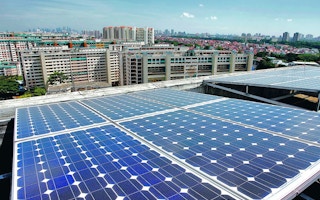A Singapore start-up has launched a trial for the country’s first peer-to-peer energy trading platform.
To continue reading, subscribe to Eco‑Business.
There's something for everyone. We offer a range of subscription plans.
- Access our stories and receive our Insights Weekly newsletter with the free EB Member plan.
- Unlock unlimited access to our content and archive with EB Circle.
- Publish your content with EB Premium.
Called Synergy, the platform will enable Singapore residents to produce, buy and sell renewable energy to one another.
Residents will be able to buy electricity from “prosumers”, consumers that double as small-scale producers when they generate extra energy, usually through rooftop solar panels.
When completed, consumers will have the option of paying for their electricity with regular currency or a cryptocurrency called Elec. The second option will log the transaction into the blockchain, which serves as a unchangeable record of the deal.
The platform was launched last month for the first phase of testing among a group of 15 consumers, prosumers and energy generators. They include households in public housing, a penthouse, and solar firm Cleantech Solar, said Julius Tan, chief executive officer and co-founder of Electrify, the company behind the platform.
In this alpha testing stage, Electrify is working to ensure that fluctuating levels of energy demand and solar energy from producers and consumers can be evened out to ensure a steady supply of electricity through its algorithms.
“We have created a way to optimise the system, so that if there’s overproduction of solar energy by one producer and underproduction another another because of cloud cover, we can take that extra energy and make up for that shortfall,” Tan explained.
He added that the company is testing the ability of its internet-of-things equipment to handle different energy production scenarios.
The test will run into the first quarter of 2019, after which a beta test with payment features will be trialled.
Electrify will eventually combine Synergy with its existing energy retail aggregation site, which functions similarly to third-party travel sites such as Agoda and Skyscanner. Tan told Eco-Business that offers from prosumers will show up alongside offers from energy retailers.
The 18 month-old start-up’s offering is not the first to use blockchain technology in peer-to-peer energy trading platforms in Southeast Asia. Shanghai’s Energo runs a project within a university campus in Manila and Power Ledger’s pilot in Bangkok operates a similar concept among buildings located within the same neighbourhood.
In contrast, Synergy is meant to be scaled across an entire city rather than a microgrid as in the Philippines example. And unlike the Bangkok project, Electrify’s platform will allow producers and consumers to trade from one end of the city to the other.
On 1 November, Singapore deregulated the energy market for consumer households, enabling residents to choose their energy provider. The government has set a goal to achieve 350 megawatt peak capacity in installed solar capacity by 2020 and 1 gigawatt beyond 2020. But being densely populated with 80 per cent of the population living in government-subsidised apartments, where will the prosumers come from?
Admitting that there “probably isn’t going to be a huge producer market”, Tan said that is why Electrify is focusing on acquiring excess power from commercial and industrial buildings with solar facilities.
Electrify aims to launch its renewed marketplace platform with Synergy and begin alpha testing in Tokyo in 2019.
Asked how he squares Synergy’s aim of boosting the renewable energy market in Singapore with the energy-intensive nature of blockchain technology, Tan said: “Current blockchain technologies are not the most energy efficient.”
But there is a lot of research exploring how to reduce the technology’s energy footprint without sacrificing blockchain’s transparency and tamper-proof nature, he added.
More energy efficient blockchain technology could then “drive down the cost of using blockchain”, said Tan.








